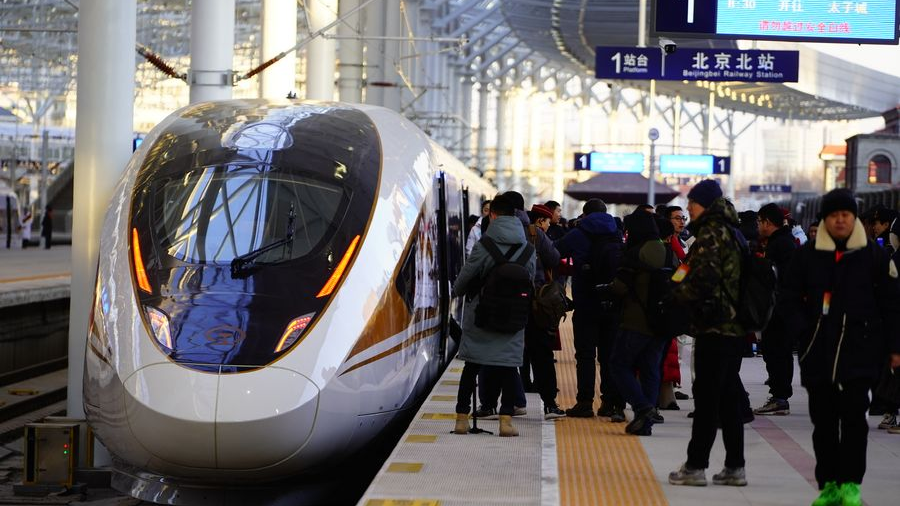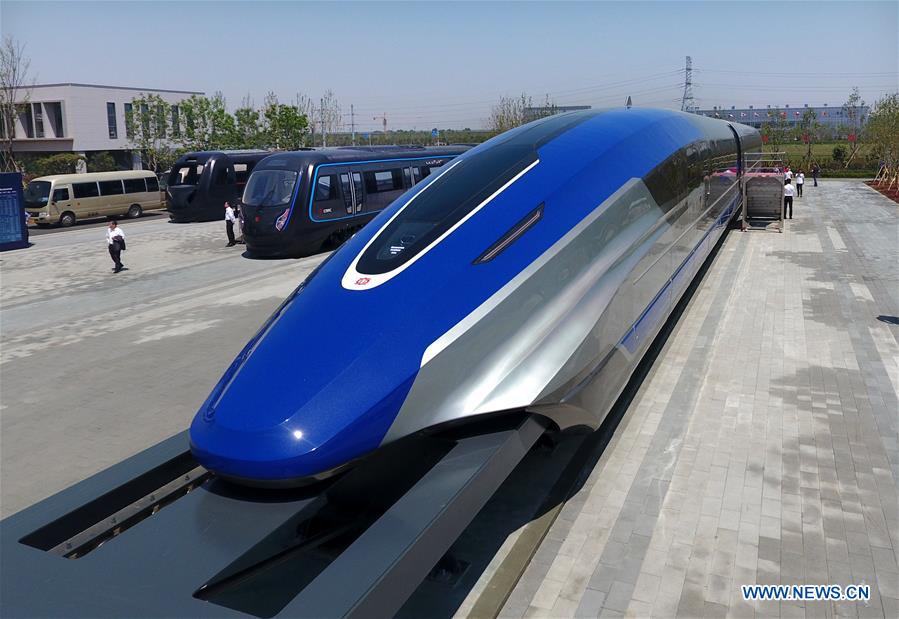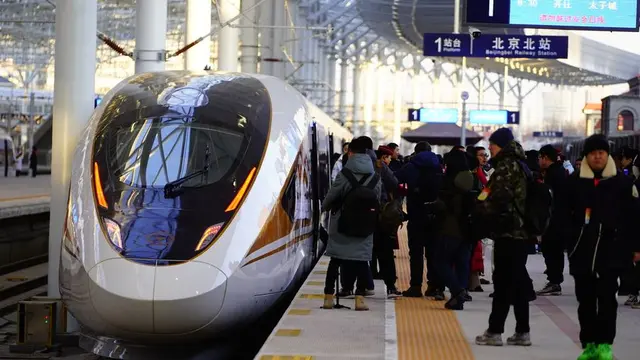
People wait to get on the G8811 high-speed train bound for Taizicheng Railway Station at Beijing North Railway Station in Beijing, capital of China, December 30, 2019. /Xinhua
Editor's note: Keith Lamb is a University of Oxford graduate with an MSc degree in Contemporary Chinese Studies. His primary research interests are international relations of China and China's "Socialism with Chinese Characteristics." The article reflects the author's opinions, and not necessarily the views of CGTN.
With 36,000 kilometers of track, China has more high-speed rail (HSR) than the rest of the world combined. It also has the second-largest railway system in the world with 141,400 km of track. In the first half of 2020, China laid 1,178 km of new rail lines of which 605 km were HSR.
Building on these achievements the National Development and Reform Commission (NDRC) said on December 4 that over the next five years China will begin construction of over 10,000 km of intercity and urban railway. By 2035 China plans to have 200,000 km of track, 70,000 km being HSR.
Three city clusters centered around Beijing, Shanghai and Guangzhou will be the target of this infrastructure project. It is expected that intercity travel times in each cluster will be less than two hours while travel within each city will not exceed an hour.
The development of public transport is exactly what one would expect in countries with socialist aspirations. Indeed, it was Deng Xiaoping, China's great reformer, who after riding Japan's HSR in 1978, seeded the aspiration to make HSR integral to China's development.
Railway infrastructure is essential for China's socialism with Chinese characteristics which seeks to build a socialist system that transcends capitalism in numerous ways such as environmental cleanliness, as well as technological and productive capacity.
China's HSR network nullifies the need for wasteful car ownership. Driving a car for any distance, compared to taking the HSR, will be both uneconomical and slow. Furthermore, China's citizens, not being stuck behind the wheel, have more time to get on with their own tasks thus China's productive capacity increases.
The cost of using China's HSR is a quarter of the base fare of other countries. This makes China's HSR competitive with air and bus travel and ensures 1.7 billion passengers a year, from all income groups, use rail. Unlike other countries, China's rail fares do not change from day to day; the price remains the same whether you buy three weeks in advance or on the day.
China's railway infrastructure also lays the groundwork for China's environmental ambitions. On an individual level, rail is a better allocation of resources in that individuals are free from the shackles of wasteful car ownership. For the country HSR is less polluting than both air and road transport in terms of greenhouse gas emissions.

China's first high-speed maglev train testing prototype in Qingdao, east China's Shandong Province, May 23, 2019. /Xinhua
Socialism with Chinese characteristics depends on long-term planning and the use of markets. In terms of railway infrastructure, China plans ahead at least 15 years while funding has come from public-private partnerships where investors get stable returns on their investment.
A World Bank study on China's HSR reported that "the rate of return of China's network, as of 2015, is estimated at 8 percent, well above the opportunity cost of capital in China and most other countries for major long-term infrastructure investments."
Ultimately, China has been able to cut down on costs due to the standardization of design and procedure which make the costs of Chinese HSR, at $17 to $21 million per km, two-thirds cheaper than anywhere else. Furthermore, as noted by the aforementioned World Bank report, much of China's cheaper costs came about due to its comprehensive HSR research and development program which was linked to the directives of China's state-led development.
However, as good as the current HSR is, it only challenges air transport for distances up to about 1,200 km. Nevertheless, China's plans for maglev transport (which looks like a train but magnetically levitates on the track) will further challenge air transport, drive on technological advancement and increase convenience.
In September, the Chinese Academy of Engineering announced that two new maglev lines, that will carry passengers at 600 km/h, will be built between 2025 and 2030. The 164 km Shanghai-Hangzhou maglev line will link up with the existing Shanghai to Pudong airport maglev and turn the journey into a 15-minute commute. The 110 km Guangzhou-Shenzhen line will eventually be connected to Hong Kong's Kowloon Station. At present, there are nine lines being planned which will, in total, stretch over 1,000 km. Lines will be built in Yunnan, Shanxi, Xinjiang, Sichuan, and Chongqing.
There are questions as to whether HSR and of course maglev is economical as not all lines in China make a profit. However, the building of HSR and future maglev lines provides an economic multiplier effect beyond the calculations of short-term profiteering. If China had wanted to maximize profits for business then it wouldn't have invested in rail. Instead, people would have been forced into the inconvenience of car ownership which would have led to quick profits at the expense of society and the environment.
In fact, rail provided at a reasonable rate leads to an incalculable economic boost to a country. For example, rail changes the patterns of urban development, encourages tourism, and promotes regional growth. As such, while China's HSR won't lead to excessive short-term profits, it does work for the greater good of all in society.
(If you want to contribute and have specific expertise, please contact us at [email protected].)
 简体中文
简体中文




